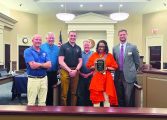Contributed by Tricia Johnson
Preservation Virginia, the oldest state-wide historic preservation organization in the country, released on May 9 its annual “Most Endangered” list of historic places in the Commonwealth facing imminent or sustained threats. Included on that list are dwellings for enslaved people across the state.
The structures once dotted the landscape. Today, buildings that historically housed men, women, and children enslaved in Fluvanna are few, and vanishing. The buildings were small log cabins or simple frame structures with clapboard or shingle siding, a central chimney, or perhaps a chimney at each end; a shake roof, or a metal one, or slate. If you know of a structure that you think might have been the dwelling place of enslaved people here, the Fluvanna Historical Society (FHS) asks that you let them know. The society will then send a representative out to look at and photograph the building, to determine whether it warrants further study. Five such buildings have been documented in the county in recent years – but there may be more, and as benign neglect, the elements, and development take their toll, the time to document them may be running out.
Sponsoring the nomination to Preservation Virginia, and leading the efforts to study these structures are two preservationists who have already been at work in Fluvanna County; Doug Sanford (formerly of UMW) and Dennis Pogue (formerly of UMD) have for more than fifteen years worked to gather and share comparative information on buildings associated with enslaved African Americans. Their Virginia Slave Housing Project travels the state, examining buildings that may have served as houses for enslaved men, women, and children. Using their considerable expertise and decades of experience, they determine whether the construction methods, materials, and patterns of use identified in a building allow them to conclude that it was indeed used as housing for enslaved people. For more on their work in Fluvanna, see the Fluvanna Review Article “Investigation confirms structure once home to enslaved people” in the June 8, 2022 edition.
“The Fluvanna Historical Society has guided us to multiple buildings, ranging from a log duplex to a frame kitchen-quarter, and to rare cases of pisé (rammed earth) construction. Even more importantly,” Sanford said, “the society has connected our work to theirs with Fluvanna County’s descendant community. Besides fostering opportunities for ongoing discussions of slavery’s legacies, such projects have the potential to contribute to restorative justice.
“Through our fieldwork we hope to encourage property owners, private citizens, and community organizations to maintain and preserve these important buildings,” Sanford said. “They represent vital cultural resources for interpreting slavery and the state’s Black heritage.”
The study of these buildings has a significant local impact, especially on those whose ancestors were enslaved here. Horace Scruggs, FHS board member and descendant of people enslaved in Fluvanna, has a deep understanding of the importance of this effort. “These dwellings are the artifacts of people who were not supposed to be remembered,” Scruggs said. “Their lives were as tattered as the places they were forced to live. So, when we make the effort to identify and possibly preserve these dwellings and spaces we are in effect giving significance to the people who lived in them.”
Reflecting on his experience visiting dwellings where his own enslaved ancestors may have lived, he added, “Knowing that my ancestors built and lived in these quarters heightens my sense of duty and urgency in making sure the dwellings are recognized. Fluvanna was full of plantations large and small with varying numbers of enslaved workers,” he pointed out. “Regardless of size of the plantation, or the number of people enslaved there, these plantations included spaces where their enslaved populations lived, raised their families, and spent what free time they had.” Scruggs added, “These spaces were in effect their homes and efforts to see them as such is integral to the process of telling their stories and humanizing their existence.”
The preservation of housing for the enslaved already identified in Fluvanna is on the list of projects soon to be undertaken by the society. Property owners have expressed an interest in finding ways to protect these buildings, and the society is an eager partner in that work. Meanwhile, the society hopes to help the Virginia Slave Housing Project study and identify as many of these structures as they can.
If you believe you know of a building once used as housing for enslaved people in Fluvanna County, please contact the FHS at fluvannahistory@gmail.com or text 434-390-1218.




